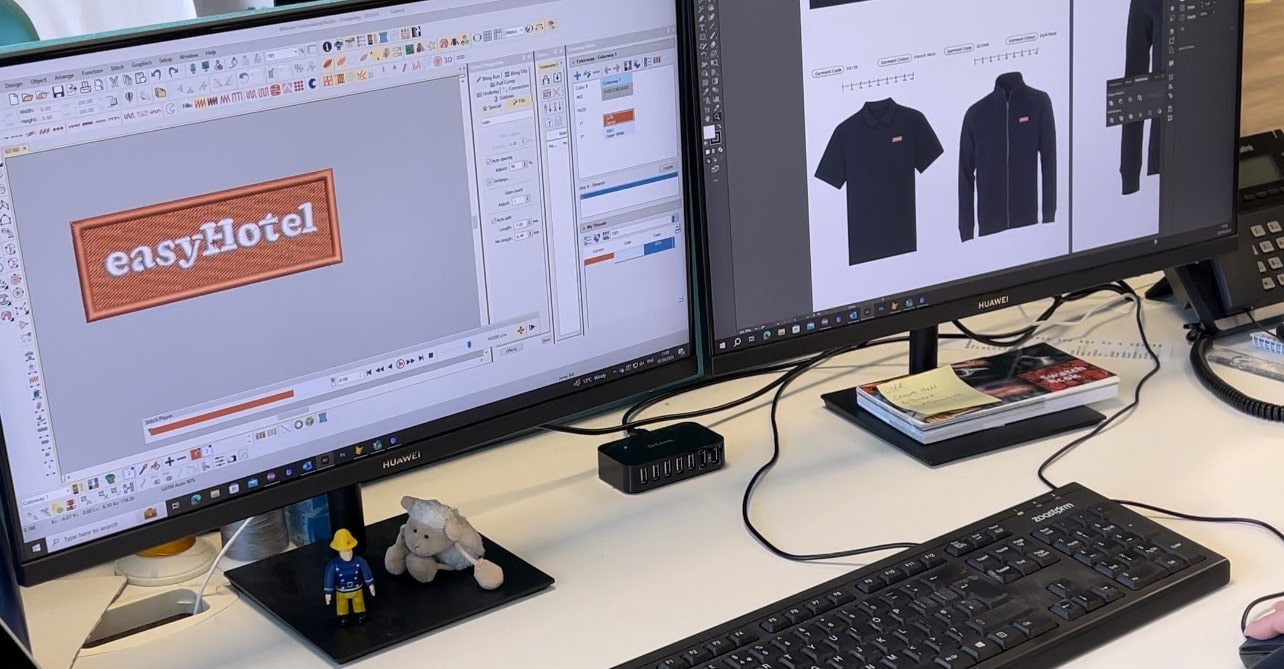Your basket is currently empty!
What File is Best for Logo Embroidery: 3 Steps to Consider
Our artwork team are wizards when it comes to preparing files for embroidery and can work their magic on almost any file quality or set up. Not keen to read the technical jargon below? No problem!
Leave the tricky stuff to us. Just send over what you have, and we’ll work our wizardry behind the scenes. You’ll receive a proof to review (because seeing is believing!) before we move ahead with production.
Think of us as your go-to team. We’ll look after you every step of the way.
Selecting the correct file type for logo embroidery is crucial to ensure your design embroiders well on fabric. Embroidery machines require a specific digital format that can translate your logo into stitches without losing any intricacies or quality.
Vector files are typically the preferred choice for creating a logo for embroidery. These files, often in formats such as .AI or .EPS, maintain the quality of your image at any size. They also allow a professional embroidery digitiser to adapt your design with precision.
The digitiser converts these vector files into an embroidery file. This file is a format that embroidery machines can read, such as .DST or .PES. This step is known as embroidery digitising and it is an essential process for converting your logo design into a stitch-ready file.
When preparing a logo file for embroidery, it’s important to consider various factors such as the level of detail, stitch types and fabric choice. The embroidery process can provide a high degree of detail, but intricate designs require careful planning to re-create successfully. That’s why knowing what file is best for logo embroidery helps avoid quality issues and ensures smooth production from the start.
1. Understanding Embroidery Files
Embroidery files are essentially digital blueprints that instruct your embroidery machine on how to create the desired stitched design. They are pivotal in transforming your logo into a high-quality embroidered piece.
Vector vs Raster
When selecting a logo file for embroidery, understanding the type of graphics file you have is crucial.
Vector files are typically the superior choice as they allow for scalability without loss of quality. These files are composed of paths defined by mathematical equations, rather than pixels, which means they can be resized easily and are ideal for creating smooth, clean embroidery designs.
On the other hand, raster files — like PNG or high-resolution JPG — are pixel-based. These are suitable for intricate designs with multiple colours or gradients. However, when these images are scaled up, they can lose resolution, which might affect the quality of the embroidered final product.
| Vector Files | Raster Files | |
| Basis | Mathematical paths | Pixels |
| Scalability | Easily scaled | Quality loss when scaled |
| Ideal For | Embroidery, Screen Printing | Digital Artwork, Detailed Images |
| Common Formats | AI, EPS, PDF, Corel Draw | PNG, JPG |
| Embroidery Software Compatibility | Often preferred | May require conversion or high degree of detail |
Embroidery File Formats
For the embroidery machine to accurately render your logo for embroidery, converting artwork to a proper embroidery file format is vital. These file formats are specific to the embroidery world and include extensions like .DST, .PES and .EMB.
- .DST (Tajima): This file type involves standard embroidery file formats used across many professional embroidery digitisers and embroidery machines. It focuses on simple stitch types like the running stitch, satin stitch and fill stitch.
- .PES (Brother): This format is specific to Brother machines and accommodates different colour threads and complex stitch densities.
- .EMB (Wilcom): This is a working, editable file format used in professional digitising software like Wilcom. Unlike stitch files, .EMB files store detailed design data including stitch types, directions, densities, thread colours, and layering order. It’s used during the design phase and is ideal for making adjustments or resizing before final production.
Embroidery files store critical information such as thread colours, stitch count, stitch direction and stitch types. It’s essential to ensure the embroidery digitising software used can handle your specific file type for optimal results. Since not all embroidery software is compatible with every file format, you should confirm compatibility before starting the embroidery process.
| File Extension | Compatibility | Characteristics |
| .DST | Most embroidery machines | Standard stitches, commonly used |
| .PES | Brother machines | Colour information, for more complex designs |
| .JEF | Janome machines | Stores stitch data for Janome embroidery formats |
| .EXP | Melco machines | Used for Melco machines; often paired with Bernina |
| .XXX | Singer machines | Format for Singer-branded embroidery systems |
| .EMB | Wilcom embroidery software | Editable master file for design development and changes |
Our talented artwork team is on hand to help set up your logo file to ensure that we are using the best file types and formats for your specific requirements, ensuring a durable decoration method across items such as t-shirts and company uniforms.
2. Choosing the Best File for Logo Embroidery
When selecting a file for logo embroidery, detail and machine compatibility are the key factors to ensure a high-quality result. The file must also include information on stitch direction to ensure the design is accurately reproduced.
From Logo to Thread: How Your Design Becomes Embroidery
When you’re getting a logo or design embroidered onto clothing, the first step is converting it into something an embroidery machine can understand. That means creating a special kind of file known as an embroidery file.
But before that can happen, you’ll need a good quality version of your logo to work from. The ideal format is a vector image like a .AI, .EPS, or .SVG file. These are made using design programmes such as Adobe Illustrator. What makes vectors perfect for embroidery is that they’re made up of scalable lines and shapes, not pixels. This means the design can be resized without losing clarity, keeping those edges smooth and sharp, which is exactly what a digitiser needs.
If you don’t have a vector version, don’t worry, high-resolution JPEGs or PNGs can still work. Just keep in mind that these are pixel-based, like photographs, so they may require extra effort. In many cases, the digitiser will need to manually trace or redraw the logo to make it suitable for embroidery.

What Is Digitising?
Digitising isn’t just a quick file conversion. It’s a detailed process of recreating your logo using stitches. Every line, curve, and colour is translated into stitch types, directions, densities, and sequencing, all through specialist embroidery software. Think of it more like creating a custom sewing pattern than simply editing an image.
This process produces a working embroidery file, such as a .EMB file (used by Wilcom software). This file holds all the editable design data, like stitch angles, thread colours, densities, and layering. It’s essentially your master file, perfect for making future edits or adapting the design for different fabrics.
Preparing for Production
While the .EMB file is great for editing, embroidery machines can’t read it directly. To run the design, it needs to be exported into a machine-readable stitch file. One of the most common is the .DST format, originally developed for Tajima machines but now widely supported. This file contains the instructions for where and how each stitch should be placed. It doesn’t include colour info or design notes, just the exact stitch path needed to embroider the design.
Different machine brands use different file types. For example:
- Brother machines use .PES
- Janome uses .JEF
- Melco uses .EXP
These formats all tell the machine how to sew the design, though some may include extras like thread colours. That’s why it’s important to know which machine will be used, so the correct file can be provided.
A Simple Way to Think About It
Here’s a helpful breakdown:
- Image file (e.g. vector) = the sketch
- .EMB file = the pattern plan
- .DST / .PES / .JEF, etc. = the final stitching instructions for the machine
Each plays a unique role:
- Image files are just a starting point, they’re useful for reference, but not for stitching.
- Editable embroidery files like .EMB are where all the real design work happens.
- Machine files like .DST are for production, they run the embroidery machine but can’t be easily changed.
So if you’re working with an embroidery supplier or digitiser, send them the cleanest logo you’ve got, ideally a vector file. They’ll take care of creating the embroidery files needed for production. And if you ever want to reuse or tweak your design later, make sure to ask for and keep a copy of the .EMB file, that’s your go-to editable version.
Resolution and Detail
For your workwear logo to be embroidered with precision, the file must have sufficient resolution to capture intricate details. High-resolution files retain the clarity of your design when converted by embroidery digitising software.
Aim for vector files such as AI or EPS, as these allow for resizing without loss of quality and can easily be converted into the stitch types needed for embroidery. When working with bitmap images, like JPG or PNG files, ensure they are high resolution, typically above 300dpi, to prevent pixelation when scaling.
Compatibility with Embroidery Machines
Embroidery machines require specific file formats that contain data on stitch count, stitch direction, and thread colours.
Commonly, a DST file is preferred as it is widely compatible with professional embroidery machines. It holds information on the running stitch, satin stitch or fill stitch that will be used to create your embroidered logo.
If you possess a vector file, professional embroidery software can convert it into a machine-readable format, preserving the delicate details for a polished final product.
3. Preparing Your Logo for Custom Embroidery
When preparing your logo for embroidery, attention to detail and the correct preparation will ensure a high-quality finish. File selection and design optimisation are crucial steps.
Optimising Design Elements
Your logo should be designed to accommodate the unique nature of embroidery, which includes considering stitch types, thread colours and fabric.
Firstly, simplify the design to avoid tiny details and thin lines that won’t translate well when stitched. Your text and graphics should use solid colours, with text no smaller than 0.25 inches in height to maintain legibility.
Detail is lost easily in embroidery, so re-create logos that focus on simple shapes and avoid fine detailing that will not embroider well. A professional embroidery digitiser can advise on the necessary adjustments to ensure the design maintains its integrity when translated to stitches.
Converting to a Suitable File Format
Embroidery machines need a specific digital artwork file to produce embroidered logos. The logo file must be converted into an embroidery file, such as DST. Most embroidery machines are compatible with this file format.
This conversion involves using embroidery digitising software. You’ll use the software to map out the stitch count, stitch direction and stitch densities of your design.
Make sure to note the different file types that different machines may use. Common file formats include .dts, .exp and .jef, among others. The digitised file informs the embroidery machine how to recreate the design with a high degree of accuracy and quality.
Vector files are often preferred for their scalability and precision. However, logos in formats such as PNG or JPG can also be used for digitising. Just make sure that the resolution is high enough.
Why Choose Essential Workwear for Custom Logo Embroidery?
At Essential Workwear, our brilliant artwork team can take care of all of the above. Remember the magic we mentioned? Think of your branded merch heading to the ball—our team’s the fairy godmother making sure it arrives looking its best. We believe that small details make a big difference, in fact, we like to call it ‘The Essential Difference‘. We’ll walk you through every step of your order. Consider us your helpful sidekick from start to finish.
We are experts in creating custom workwear for your brand or business. Whether you want your logo added to t-shirts, polo shirts, jackets or hoodies, we’ll have your work uniforms sporting your company name in no time! Our top-of-the-line Barudan embroidery machines can highlight your brand’s logo fantastically.
We offer both embroidery and printing as application methods for branded workwear. To start the order process, you can request a quote or contact us at +44 (0)330 202 1001 or sales@essentialworkwear.com. One of our sales members can then discuss the details with you, regarding colour, product quantities and logo size.

























